Focus prosody in Japanese reconsidered
DOI:
https://doi.org/10.3765/plsa.v3i1.4291Keywords:
focus, prosody, prosodic categories, accent, intonation, JapaneseAbstract
Japanese is a pitch accent language where lexical items are divided into two groups: Accented (A) and Unaccented (U). Previous studies suggest that, for A words, focus boosts the pitch of the accent peak and triggers either compression of the pitch range and/or Downstep in the post-focal domain, but they are not clear on how focus on U words is implemented. The purpose of the paper is to examine how focus in Japanese is realized and perceived in various accentual conditions by production and perception experiments which tightly controlled the focus status and accent status of word pairs. We predict that, similar to focus on A words, focused U words will be endowed with F0 Rise and Post-focal Fall, and listeners can identify focus with high accuracy. Our results show that U words have the focal characteristics of F0 Rise and Post-focal Fall, but failed to show up constantly in all sequences considered, which leads to a significant difference in perception between the focus on U words and the one on A words. There are controversies over whether focus builds its own independent prosodic phrase in the Japanese literature. If focus necessarily initiates a new Phonological (Major) Phrase, we would not expect such murky results as ours, so we should conclude that focus does not initiate a new prosodic category, which accords with Ishihara (2003) and others.Published
2018-03-03
Issue
Section
Articles
License
Published by the LSA with permission of the author(s) under a CC BY 4.0 license.
How to Cite
Mizuguchi, Shinobu, and Koichi Tateishi. 2018. “Focus Prosody in Japanese Reconsidered”. Proceedings of the Linguistic Society of America 3 (1): 12:1–5. https://doi.org/10.3765/plsa.v3i1.4291.
